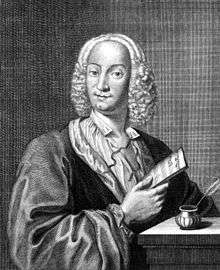Scanderbeg (opera)
For other uses, see Skanderbeg (disambiguation).
| Antonio Vivaldi |
|---|
 |
|
Operas
|
Scanderbeg (Italian pronunciation: [ˈskanderbeɡ]; RV 732) is an opera (dramma per musica) in three acts composed by Antonio Vivaldi to an Italian libretto by Antonio Salvi. It was first performed at the Teatro della Pergola in Florence on 22 June 1718 to mark the re-opening of the theatre to public performances.[1] While the libretto has been preserved, only fragments of the original score remain.[2]
Roles
| Role | Voice type | Premiere Cast 22 June 1718[3] |
|---|---|---|
| Scanderbeg, King of Albania | alto castrato | Giovanni Battista Carboni |
| Doneca, his wife, disguised as a shepardess | soprano | Francesca Cuzzoni-Sandoni, 'La Parmigiana' |
| Aroniz, Price of Epirus, father of Doneca, disguised as a shepherd | tenor | Antonio Ristorini |
| Ormondo, Count of Urana, army general | alto castrato | Giovanni Pietro Sbaraglia, "Il Pesciatino" |
| Climene, Scanderbeg's captain | soprano (travesti) | Anna Guglielmini |
| Amurat II, monarch of the Turks | tenore | Gaetano Mossi |
| Asteria, his daughter | contralto | Agata Landi |
| Acomat, Amurat's general, in love with Asteria | soprano (travesti) | Rosa Venturini |
Synopsis
The subject of the opera is Skanderbeg, the 15th-century Albanian hero.
Recordings
Two arias the opera's second act, "S'a voi penso, o luci belle" (Ormondo) and "Con palme ed allori" (Scanderbeg), can be heard on Arie ritrovate sung by contralto Sonia Prina with the Accademia Bizantina, conducted by Ottavio Dantone (Naïve Records).
References
Notes
Sources
- Casaglia, Gherardo (2005) "22 Giugno 1718". Almanacco Amadeus. Accessed 20 April 2011 (Italian).
- Colas, Damien and Di Profio, Alessandro (2009). D'une scène à l'autre, l'opéra italien en Europe: Les pérégrinations d'un genre. Mardaga. ISBN 2-87009-992-4 (French)
- Holmes, William (1994). Opera observed: Views of a Florentine impresario in the early eighteenth century. University of Chicago Press. ISBN 0-226-34970-5
- Strohm, Reinhard (2008a). The operas of Antonio Vivaldi. Florence: Olschki. ISBN 978-88-222-5682-9
- Strohm, Reinhard (2008b). Essays on Handel and Italian Opera. Cambridge University Press. ISBN 0-521-08835-6
This article is issued from Wikipedia - version of the 11/7/2016. The text is available under the Creative Commons Attribution/Share Alike but additional terms may apply for the media files.